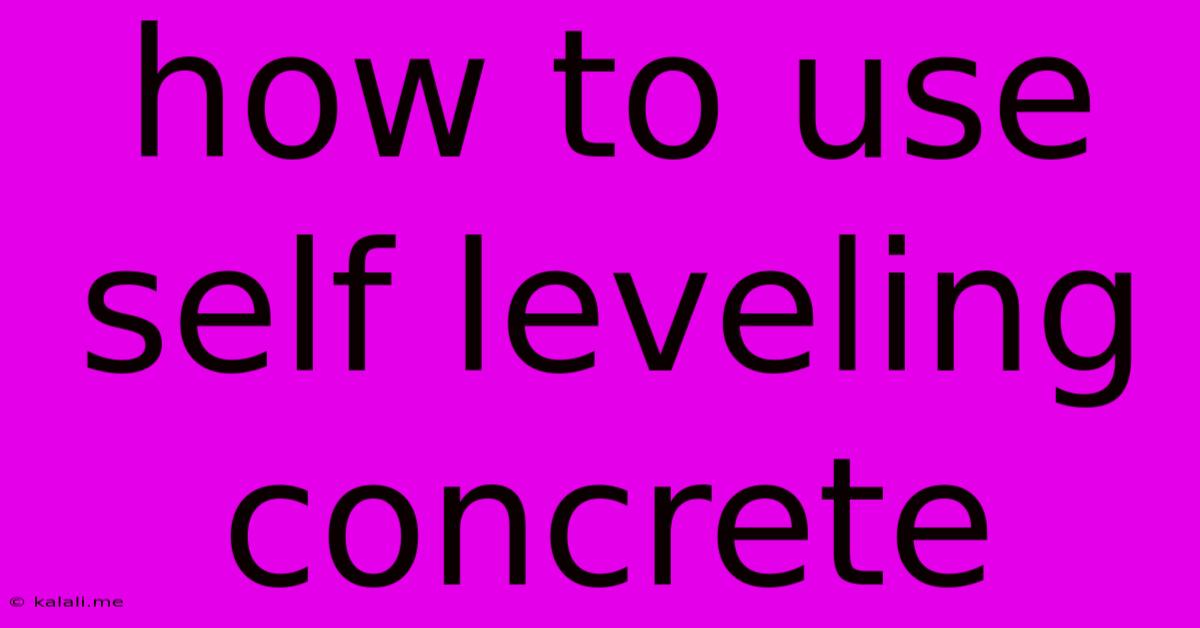How To Use Self Leveling Concrete
Kalali
Jun 04, 2025 · 3 min read

Table of Contents
How to Use Self-Leveling Concrete: A Comprehensive Guide
Self-leveling concrete, also known as self-leveling compound (SLC) or concrete leveler, is a fantastic solution for creating smooth, even surfaces for floors, patios, and other applications. This guide will walk you through the process of using self-leveling concrete, from preparation to finishing touches, ensuring a professional-looking result. This guide covers everything from choosing the right product to troubleshooting common issues, making your DIY project a success.
Understanding Self-Leveling Concrete
Self-leveling concrete is a mixture of cement, polymers, and aggregates designed to flow easily and self-level to create a perfectly flat surface. It's a popular choice for both interior and exterior projects, offering a durable and aesthetically pleasing finish. Key benefits include its ease of application, fast drying time (compared to traditional concrete pouring), and the ability to cover minor imperfections in the subfloor. Before you begin, understanding its properties and limitations will help ensure a successful project.
Step-by-Step Guide to Applying Self-Leveling Concrete
1. Preparation is Key: This is arguably the most crucial step. A poorly prepared surface will lead to an uneven and potentially damaged finish.
- Clean the Subfloor: Thoroughly remove any dust, debris, grease, or other contaminants from the surface. A powerful vacuum cleaner is highly recommended. For extremely dirty surfaces, consider using a pressure washer.
- Repair Cracks and Holes: Address any significant cracks or holes in the subfloor using appropriate patching compounds. Allow ample time for these repairs to cure completely before proceeding.
- Prime the Surface: Applying a primer helps improve adhesion and prevents the self-leveling concrete from absorbing too quickly into the subfloor, leading to an uneven finish. Choose a primer specifically designed for concrete.
- Moisture Barrier: In high-humidity environments or over concrete prone to moisture problems, a moisture barrier, such as a polyethylene sheet, is essential to prevent moisture migration and potential damage to the SLC.
2. Mixing the Self-Leveling Concrete:
- Follow Manufacturer's Instructions: Mixing ratios and techniques vary by brand and type of self-leveling concrete. Always adhere strictly to the instructions on the product packaging.
- Use Clean Tools: Employ clean buckets and mixing tools to avoid introducing contaminants that could affect the curing process.
- Consistent Mixing: Mix the self-leveling concrete thoroughly to ensure a uniform consistency. Avoid over-mixing, which can introduce air bubbles.
3. Pouring and Spreading the SLC:
- Start in a Corner: Begin pouring the self-leveling concrete in a corner of the area and gradually work your way outwards.
- Even Distribution: Spread the mixture using a notched trowel or a specialized self-leveling concrete rake to ensure even distribution. The goal is a consistent layer thickness; check the manufacturer's recommendations.
- Avoid Air Bubbles: Gently rake the mixture to minimize air bubbles. A spiked roller can further help eliminate trapped air.
4. Finishing Touches:
- Allow for Curing: Once the self-leveling concrete has set, allow it to cure completely according to the manufacturer’s instructions. Avoid foot traffic during this time.
- Protect from Extreme Temperatures: Prevent direct sunlight or extreme temperature fluctuations during the curing process.
5. Troubleshooting Common Issues:
- Uneven Surface: This often results from inadequate preparation or inconsistent pouring/spreading.
- Cracking: This may be due to insufficient curing time, rapid drying, or incorrect mixing.
- Air Bubbles: Thorough mixing and the use of a spiked roller can help prevent this.
Choosing the Right Self-Leveling Concrete
The choice of self-leveling concrete depends on several factors:
- Thickness Required: Different products are designed for different thicknesses.
- Application Area: Interior or exterior use will influence your choice.
- Surface Type: The substrate (wood, concrete, etc.) impacts selection.
- Drying Time: Faster-setting options are available for quicker turnaround.
By following these steps and paying close attention to detail, you can achieve a professional-looking, smooth, and level surface using self-leveling concrete. Remember, careful preparation is the key to a successful project. If you are unsure about any aspect of the process, it’s always best to consult with a concrete professional.
Latest Posts
Latest Posts
-
Best Framerate Limit For Skyrim Se
Jun 06, 2025
-
How To Describe A Old Style Bar
Jun 06, 2025
-
20 Amp Receptacle On 15 Amp Circuit
Jun 06, 2025
-
Is It Illegal To Open Someone Elses Mail
Jun 06, 2025
-
Active Object Is Not A Selected Mesh
Jun 06, 2025
Related Post
Thank you for visiting our website which covers about How To Use Self Leveling Concrete . We hope the information provided has been useful to you. Feel free to contact us if you have any questions or need further assistance. See you next time and don't miss to bookmark.